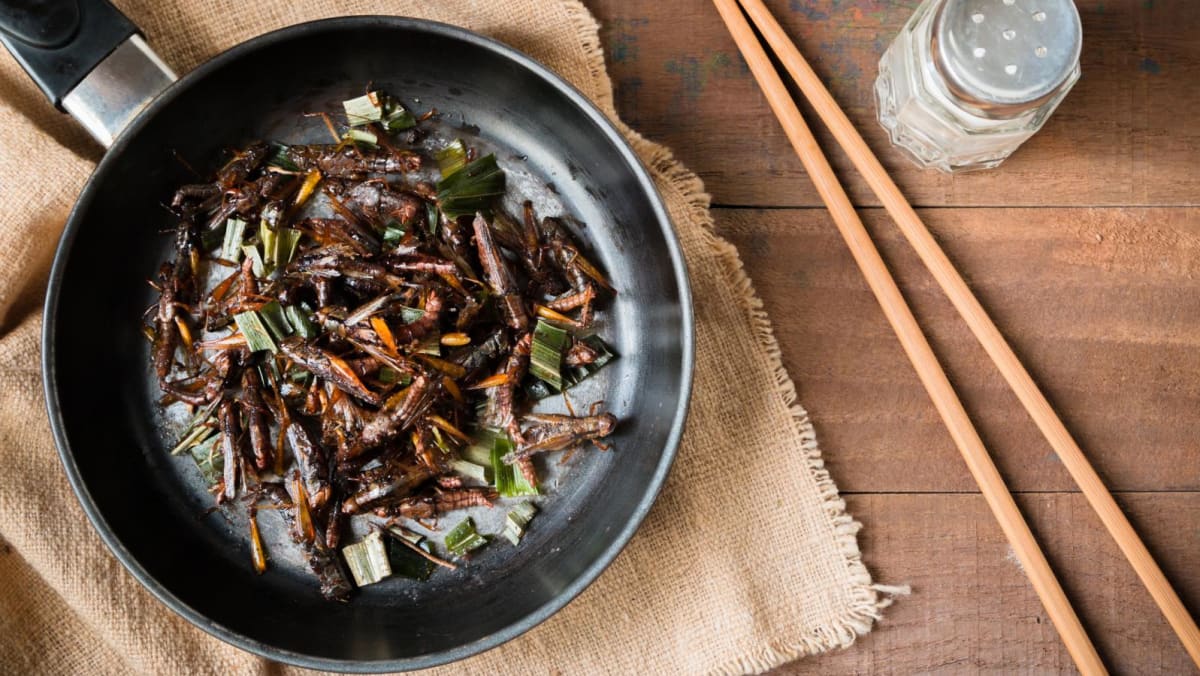While insects are commonly prepared as deep-fried food, there are healthier cooking methods without compromising on texture.
Roasting, baking or even air frying can retain the crispiness of insects without additional trans fats, said Asst Prof Puniamoorthy.
“There are also delicious recipes that involve the boiling, braising, or steaming of insects such as the beondegi or silkworm pupae in South Korea. There are also products that simply use dehydrating to dry the insects or grinding insects into powders to be used in baking or incorporation into other foods.”
DOES THE ENVIRONMENT BENEFIT?
Nutrition reasons aside, opting for insects on the dinner table can be a plus for the environment as well.
“I think it is important to emphasise that insects are a highly sustainable food source. They require less land, water, and feed compared to traditional livestock, and most importantly, they have a reduced environmental footprint which can support greener food systems,” stressed Asst Prof Puniamoorthy.
“Insects present a promising solution for nutritional value and as a society, we may need to adapt and shift.”
Insects are also an overlooked source of protein and a way to battle climate change, the World Economic Forum (WEF) said in 2022.
Among the advantages is that edible insects can produce equivalent amounts of “quality protein” when compared with methane-producing animals.
Beef has the highest greenhouse gas emissions on a per kg basis and pork came out tops on a per capita basis, according to a Singapore-centric study commissioned by investment firm Temasek and carried out by the Agency for Science, Technology and Research (A*STAR) and Deloitte, and published in 2019.
Insects, on the other hand, produce much smaller quantities of greenhouse gases per kg of meat than livestock like cattle and pigs.
A pig produces between 10 to 100 times as much greenhouse gases per kg compared with mealworms for example, a 2011 study by the Wageningen University & Research, which specialises in life sciences and agriculture, said.
WHY ARE WE EATING BEES?
The importance of bees as pollinators is well-known, so it might seem counterintuitive at first that they can also be eaten as food.
A study published in the Journal of Apicultural Research in 2016 noted that many cultures, including those in Thailand and Australia, consume honey bee brood, also referred to as larvae, as a cultural practice.
They are also eaten for their taste, described as being nutty and slightly sour with a crunchy texture when eaten cooked or dried.
In certain regions, beekeepers routinely remove portions of a hives’ drone brood in order to manage the growth of a harmful parasitical mite that can harm the honey bee population, said the study.
“This practice makes honey bee drone brood a by-product, producing an abundant source of farmed insects with untapped potential,” wrote Professor Annette Bruun Jensen of the University of Copenhagen and her colleagues.
“The high nutritional value of honey bee larvae and pupae that can be compared to beef by its protein quality and quantity.”
The setting up of hives and beekeeping practices could also help in providing pollination services – stimulating ecological robustness and agricultural production in an area, the researchers noted.
The Western honey bees that are available for consumption in Singapore must be farmed in a controlled environment and are not allowed to be harvested from the wild, as per SFA rules.
These bees will also likely be fully processed as they are among the insects not allowed to be imported live, with the National Parks Board (NParks) having assessed them to be an invasive species.
ARE INSECTS REALLY SAFE?
SFA has developed an insect regulatory framework that establishes guidelines for businesses that intend to import, farm or process insects into food for human consumption or animal feed.
First, the insect species must be assessed to have a history of human consumption. The farming and processing of insect and insect products must also be free from contaminants, with the final product evaluated to be safe for consumption.
The 16 species of insects approved as food in Singapore cannot be caught from the wild.
The agency said the guidelines were developed following a “thorough scientific review” that took reference from countries and regions that have allowed the consumption of certain insects as food.
These include the European Union, Australia, New Zealand, South Korea and Thailand.
Hygiene protocols must also be closely followed.
House of Seafood CEO Francis Ng previously told CNA that his chefs have been trained to first clean the insects before toasting them in the oven. This method is then followed by the brushing of each insect “piece by piece”.
“One should purchase products from certified suppliers that provide clear labelling and information. Consumers should pay attention to shelf life and storage products in proper conditions as advised by the manufacturers,” advised Asst Prof Puniamoorthy.
SO WHAT DO THEY TASTE LIKE?
Based on a recent Instagram poll by CNA, more than 80 per cent of respondents were reluctant to try insects. Several commenters cited the ick factor. “This bugs me. I’ll pass,” said a netizen.
The poll accompanied a taste test video where the ikan bilis or fried anchovy component of a plate of nasi lemak was replaced with house crickets, field crickets and silkworms.
The general consensus among those who tried the insects? A few “ews”, some “good” and “not too bad” reactions, and one “ashy” – in reference to the crumbly texture. Some even went back for seconds and thirds.

